MGT5STR: Strategic Analysis of Tassal Group Limited in Aquaculture
VerifiedAdded on 2023/03/31
|11
|1896
|91
Report
AI Summary
This report provides a strategic analysis of Tassal Group Limited, an organization operating in the Australian aquaculture industry. It examines the demands within the industry, the generic strategies implemented by Tassal Group, and an external analysis using Porter’s Five Forces model. The report identifies the company's business units, revenue streams, and key strategies such as cost leadership and differentiation. It also includes an implementation and evaluation plan for a recommended strategy focused on expanding production plants and enhancing the product portfolio. Recommendations for the future strategic direction of Tassal Group Limited are provided to enhance its competitive position and ensure sustainable operations in the face of increasing competition and evolving customer demands. Desklib provides solved assignments for students.
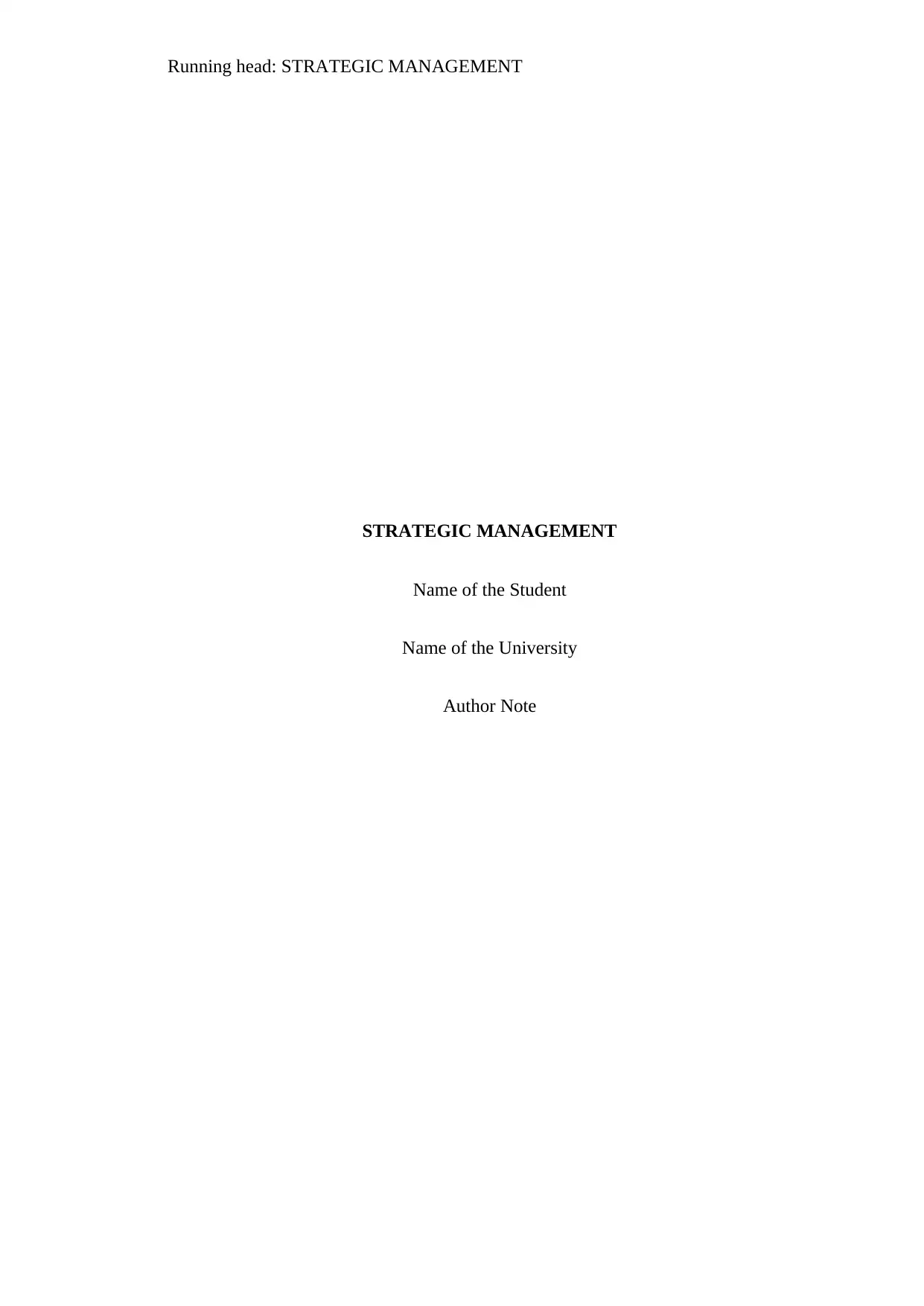
Running head: STRATEGIC MANAGEMENT
STRATEGIC MANAGEMENT
Name of the Student
Name of the University
Author Note
STRATEGIC MANAGEMENT
Name of the Student
Name of the University
Author Note
Paraphrase This Document
Need a fresh take? Get an instant paraphrase of this document with our AI Paraphraser
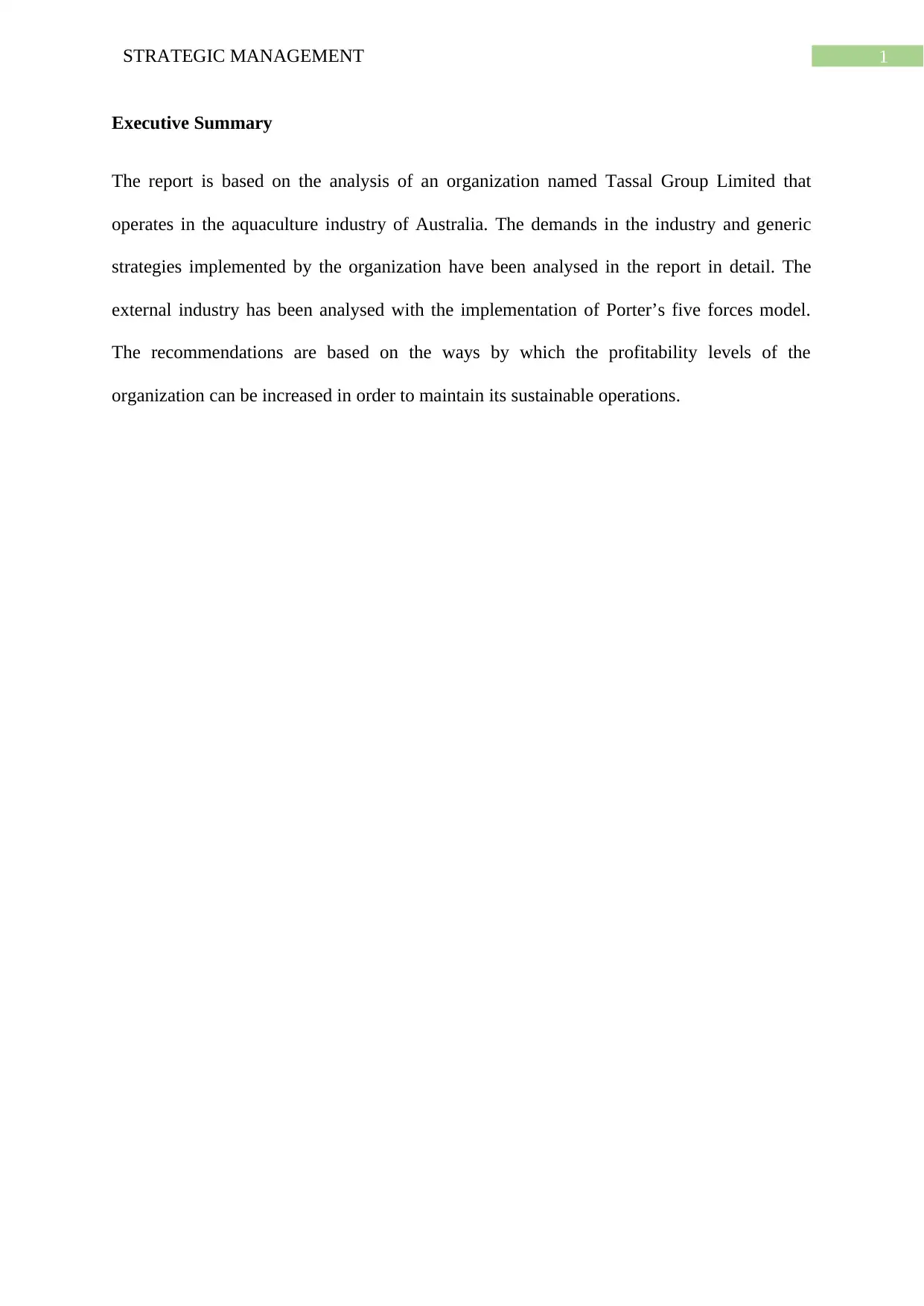
1STRATEGIC MANAGEMENT
Executive Summary
The report is based on the analysis of an organization named Tassal Group Limited that
operates in the aquaculture industry of Australia. The demands in the industry and generic
strategies implemented by the organization have been analysed in the report in detail. The
external industry has been analysed with the implementation of Porter’s five forces model.
The recommendations are based on the ways by which the profitability levels of the
organization can be increased in order to maintain its sustainable operations.
Executive Summary
The report is based on the analysis of an organization named Tassal Group Limited that
operates in the aquaculture industry of Australia. The demands in the industry and generic
strategies implemented by the organization have been analysed in the report in detail. The
external industry has been analysed with the implementation of Porter’s five forces model.
The recommendations are based on the ways by which the profitability levels of the
organization can be increased in order to maintain its sustainable operations.
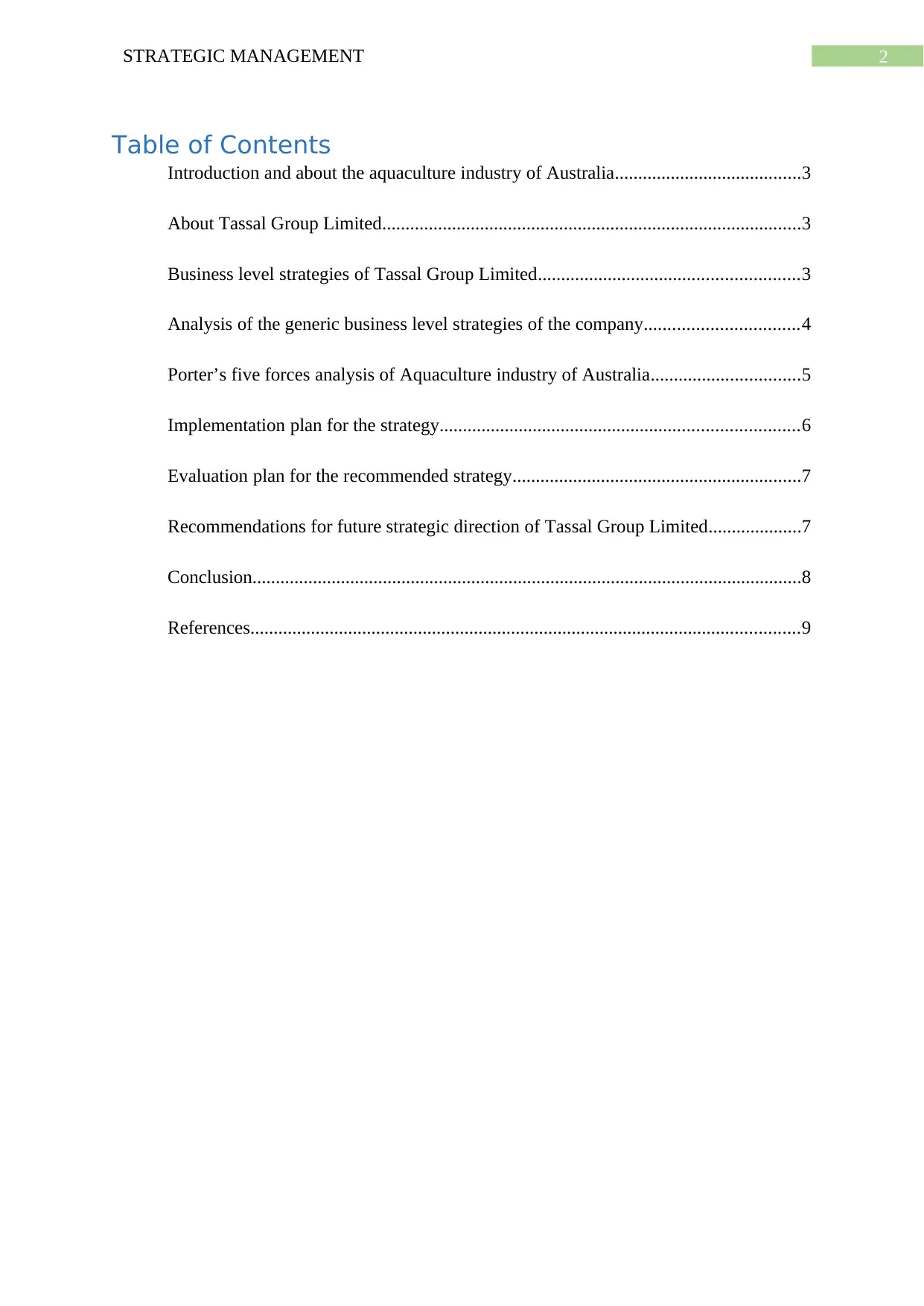
2STRATEGIC MANAGEMENT
Table of Contents
Introduction and about the aquaculture industry of Australia........................................3
About Tassal Group Limited..........................................................................................3
Business level strategies of Tassal Group Limited........................................................3
Analysis of the generic business level strategies of the company.................................4
Porter’s five forces analysis of Aquaculture industry of Australia................................5
Implementation plan for the strategy.............................................................................6
Evaluation plan for the recommended strategy..............................................................7
Recommendations for future strategic direction of Tassal Group Limited....................7
Conclusion......................................................................................................................8
References......................................................................................................................9
Table of Contents
Introduction and about the aquaculture industry of Australia........................................3
About Tassal Group Limited..........................................................................................3
Business level strategies of Tassal Group Limited........................................................3
Analysis of the generic business level strategies of the company.................................4
Porter’s five forces analysis of Aquaculture industry of Australia................................5
Implementation plan for the strategy.............................................................................6
Evaluation plan for the recommended strategy..............................................................7
Recommendations for future strategic direction of Tassal Group Limited....................7
Conclusion......................................................................................................................8
References......................................................................................................................9
⊘ This is a preview!⊘
Do you want full access?
Subscribe today to unlock all pages.

Trusted by 1+ million students worldwide

3STRATEGIC MANAGEMENT
Introduction and about the aquaculture industry of Australia
As discussed by Bruce and Faunce (2017), agribusiness can be defined as the business
that is mainly based on the levels of agricultural production that is developed in different
countries. The different activities that are a part of the agribusiness based operations in
different industries include, crop production, agrichemicals, processing, seed supply and farm
machinery.
The growth of population in Australia has further led to the increase in demands for
the sources of food that are sustainable in nature. The demands for seafood have increased in
a huge manner in the last few years. The seafood demands have started exceeding the levels
of domestic production in the country. The process of domestic aquaculture is considered to
be an important aspect that has a major impact on the ways by which demands can be met.
The gross value of the aquaculture production has increased by around 12%
(Agriculture.gov.au 2019).
About Tassal Group Limited
Tassal Group Limited is an island that has a major maritime history and cool waters
as well. The major ambition of the organization is to produce fresh and healthy salmon that
had started greater than 30 years ago. Major importance is provided by the organization and
the management to development of quality food products. Sustainability is considered to be
the most important part of the operations that are performed by the organization
(Tassal.com.au 2019).
Business level strategies of Tassal Group Limited
The survival of an organization in the industry is mainly based on the advantage that
it is able to gain in the industry in comparison to its competitors. The development of a clear
differentiation with the help of its products is considered to be an important factor that can
Introduction and about the aquaculture industry of Australia
As discussed by Bruce and Faunce (2017), agribusiness can be defined as the business
that is mainly based on the levels of agricultural production that is developed in different
countries. The different activities that are a part of the agribusiness based operations in
different industries include, crop production, agrichemicals, processing, seed supply and farm
machinery.
The growth of population in Australia has further led to the increase in demands for
the sources of food that are sustainable in nature. The demands for seafood have increased in
a huge manner in the last few years. The seafood demands have started exceeding the levels
of domestic production in the country. The process of domestic aquaculture is considered to
be an important aspect that has a major impact on the ways by which demands can be met.
The gross value of the aquaculture production has increased by around 12%
(Agriculture.gov.au 2019).
About Tassal Group Limited
Tassal Group Limited is an island that has a major maritime history and cool waters
as well. The major ambition of the organization is to produce fresh and healthy salmon that
had started greater than 30 years ago. Major importance is provided by the organization and
the management to development of quality food products. Sustainability is considered to be
the most important part of the operations that are performed by the organization
(Tassal.com.au 2019).
Business level strategies of Tassal Group Limited
The survival of an organization in the industry is mainly based on the advantage that
it is able to gain in the industry in comparison to its competitors. The development of a clear
differentiation with the help of its products is considered to be an important factor that can
Paraphrase This Document
Need a fresh take? Get an instant paraphrase of this document with our AI Paraphraser
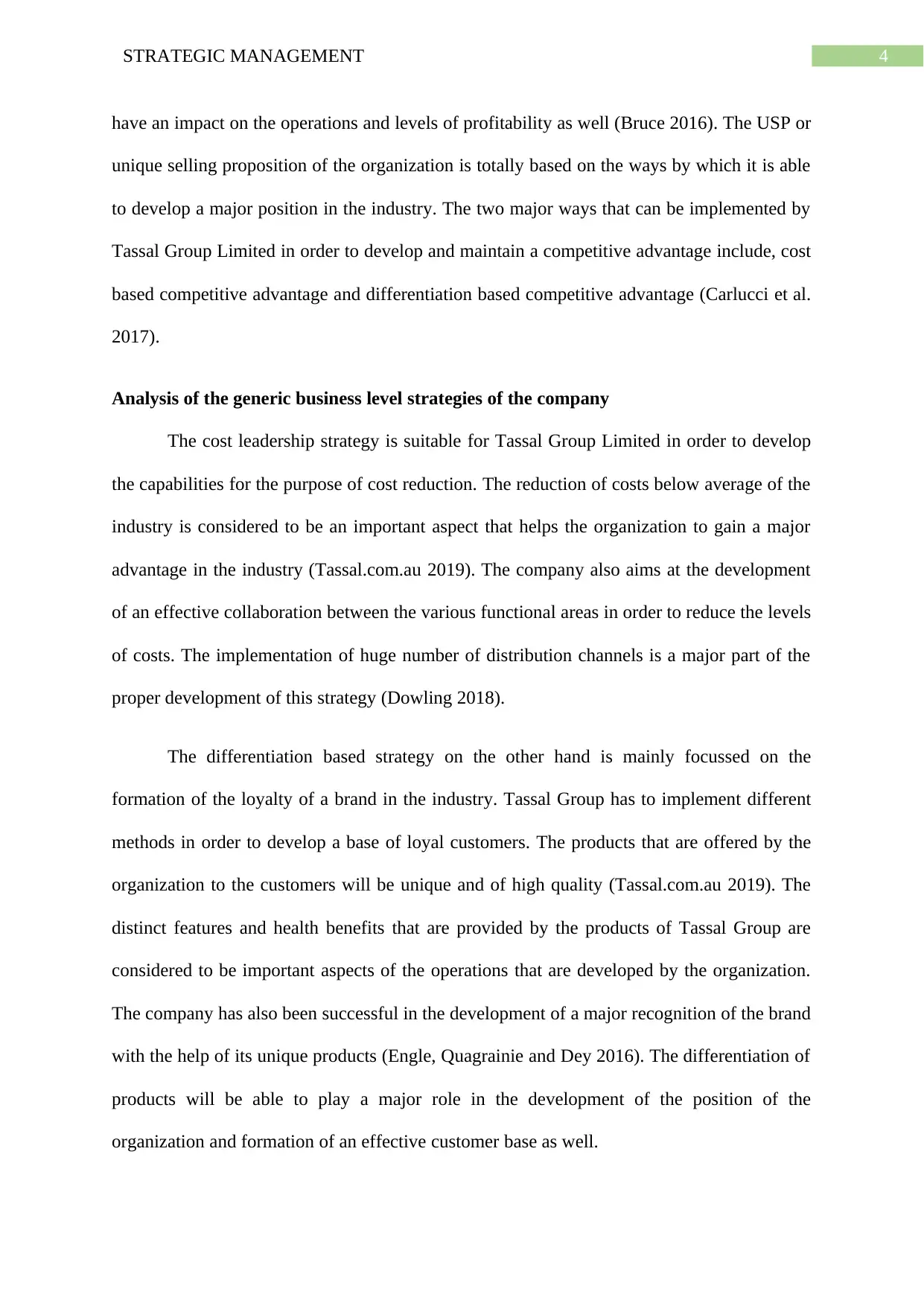
4STRATEGIC MANAGEMENT
have an impact on the operations and levels of profitability as well (Bruce 2016). The USP or
unique selling proposition of the organization is totally based on the ways by which it is able
to develop a major position in the industry. The two major ways that can be implemented by
Tassal Group Limited in order to develop and maintain a competitive advantage include, cost
based competitive advantage and differentiation based competitive advantage (Carlucci et al.
2017).
Analysis of the generic business level strategies of the company
The cost leadership strategy is suitable for Tassal Group Limited in order to develop
the capabilities for the purpose of cost reduction. The reduction of costs below average of the
industry is considered to be an important aspect that helps the organization to gain a major
advantage in the industry (Tassal.com.au 2019). The company also aims at the development
of an effective collaboration between the various functional areas in order to reduce the levels
of costs. The implementation of huge number of distribution channels is a major part of the
proper development of this strategy (Dowling 2018).
The differentiation based strategy on the other hand is mainly focussed on the
formation of the loyalty of a brand in the industry. Tassal Group has to implement different
methods in order to develop a base of loyal customers. The products that are offered by the
organization to the customers will be unique and of high quality (Tassal.com.au 2019). The
distinct features and health benefits that are provided by the products of Tassal Group are
considered to be important aspects of the operations that are developed by the organization.
The company has also been successful in the development of a major recognition of the brand
with the help of its unique products (Engle, Quagrainie and Dey 2016). The differentiation of
products will be able to play a major role in the development of the position of the
organization and formation of an effective customer base as well.
have an impact on the operations and levels of profitability as well (Bruce 2016). The USP or
unique selling proposition of the organization is totally based on the ways by which it is able
to develop a major position in the industry. The two major ways that can be implemented by
Tassal Group Limited in order to develop and maintain a competitive advantage include, cost
based competitive advantage and differentiation based competitive advantage (Carlucci et al.
2017).
Analysis of the generic business level strategies of the company
The cost leadership strategy is suitable for Tassal Group Limited in order to develop
the capabilities for the purpose of cost reduction. The reduction of costs below average of the
industry is considered to be an important aspect that helps the organization to gain a major
advantage in the industry (Tassal.com.au 2019). The company also aims at the development
of an effective collaboration between the various functional areas in order to reduce the levels
of costs. The implementation of huge number of distribution channels is a major part of the
proper development of this strategy (Dowling 2018).
The differentiation based strategy on the other hand is mainly focussed on the
formation of the loyalty of a brand in the industry. Tassal Group has to implement different
methods in order to develop a base of loyal customers. The products that are offered by the
organization to the customers will be unique and of high quality (Tassal.com.au 2019). The
distinct features and health benefits that are provided by the products of Tassal Group are
considered to be important aspects of the operations that are developed by the organization.
The company has also been successful in the development of a major recognition of the brand
with the help of its unique products (Engle, Quagrainie and Dey 2016). The differentiation of
products will be able to play a major role in the development of the position of the
organization and formation of an effective customer base as well.

5STRATEGIC MANAGEMENT
Porter’s five forces analysis of Aquaculture industry of Australia
The competitive environment in which Tassal Group Limited operates can be
analysed in a detailed manner with the help of implementation of the Porter’s five forces
framework. The five forces that are a part of this model can be used in order to analyse the
operations of the organization and the industry in which it operates as well (Hine 2015).
Threats of the new entrants – The threats that are faced by the organization related to
the entry of new companies in the industry are quite high due to the increase that has been
seen in the demands of products. The implementation of innovation in the products can be a
major factor that will be helpful in the reduction of threats from the new organizations
(Kirkpatrick, Kriwoken and Styger 2019).
Bargaining power of the suppliers – The suppliers on aquaculture industry are able to
play a major role in the development of products that are offered to the customers. The
development of an efficient chain of suppliers by Tassal Group is able to reduce the levels of
threats in a huge way. The formation of third party manufacturers can help in the reduction of
power of the suppliers (Lacoste et al. 2017).
Bargaining power of the buyers – The demands of buyers in the industry are huge
and the presence of different organizations can also lead to the reduction of levels of
profitability in the industry. The rapid innovation of products will be able to help the
organization to develop a loyal customer base (Lawley and Birch 2016).
Threats of substitute products – The new services or products are able to play a
major role in the development of threats that are provided to Tassal Group Limited. The
threats that are thereby faced by the organization based on development of a unique value
proposition have an impact on the operations (Rahman et al. 2018).
Porter’s five forces analysis of Aquaculture industry of Australia
The competitive environment in which Tassal Group Limited operates can be
analysed in a detailed manner with the help of implementation of the Porter’s five forces
framework. The five forces that are a part of this model can be used in order to analyse the
operations of the organization and the industry in which it operates as well (Hine 2015).
Threats of the new entrants – The threats that are faced by the organization related to
the entry of new companies in the industry are quite high due to the increase that has been
seen in the demands of products. The implementation of innovation in the products can be a
major factor that will be helpful in the reduction of threats from the new organizations
(Kirkpatrick, Kriwoken and Styger 2019).
Bargaining power of the suppliers – The suppliers on aquaculture industry are able to
play a major role in the development of products that are offered to the customers. The
development of an efficient chain of suppliers by Tassal Group is able to reduce the levels of
threats in a huge way. The formation of third party manufacturers can help in the reduction of
power of the suppliers (Lacoste et al. 2017).
Bargaining power of the buyers – The demands of buyers in the industry are huge
and the presence of different organizations can also lead to the reduction of levels of
profitability in the industry. The rapid innovation of products will be able to help the
organization to develop a loyal customer base (Lawley and Birch 2016).
Threats of substitute products – The new services or products are able to play a
major role in the development of threats that are provided to Tassal Group Limited. The
threats that are thereby faced by the organization based on development of a unique value
proposition have an impact on the operations (Rahman et al. 2018).
⊘ This is a preview!⊘
Do you want full access?
Subscribe today to unlock all pages.

Trusted by 1+ million students worldwide
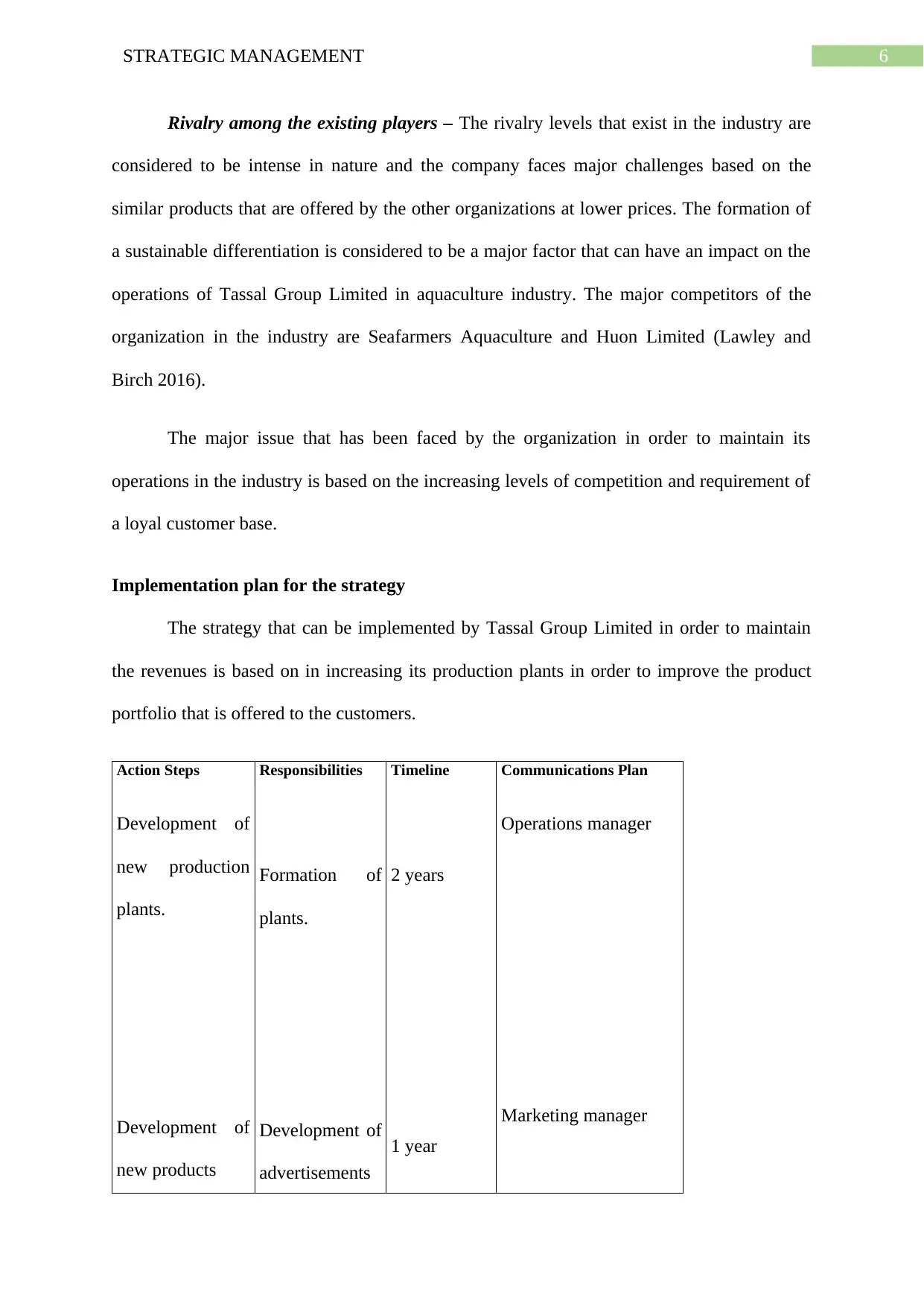
6STRATEGIC MANAGEMENT
Rivalry among the existing players – The rivalry levels that exist in the industry are
considered to be intense in nature and the company faces major challenges based on the
similar products that are offered by the other organizations at lower prices. The formation of
a sustainable differentiation is considered to be a major factor that can have an impact on the
operations of Tassal Group Limited in aquaculture industry. The major competitors of the
organization in the industry are Seafarmers Aquaculture and Huon Limited (Lawley and
Birch 2016).
The major issue that has been faced by the organization in order to maintain its
operations in the industry is based on the increasing levels of competition and requirement of
a loyal customer base.
Implementation plan for the strategy
The strategy that can be implemented by Tassal Group Limited in order to maintain
the revenues is based on in increasing its production plants in order to improve the product
portfolio that is offered to the customers.
Action Steps
Development of
new production
plants.
Development of
new products
Responsibilities
Formation of
plants.
Development of
advertisements
Timeline
2 years
1 year
Communications Plan
Operations manager
Marketing manager
Rivalry among the existing players – The rivalry levels that exist in the industry are
considered to be intense in nature and the company faces major challenges based on the
similar products that are offered by the other organizations at lower prices. The formation of
a sustainable differentiation is considered to be a major factor that can have an impact on the
operations of Tassal Group Limited in aquaculture industry. The major competitors of the
organization in the industry are Seafarmers Aquaculture and Huon Limited (Lawley and
Birch 2016).
The major issue that has been faced by the organization in order to maintain its
operations in the industry is based on the increasing levels of competition and requirement of
a loyal customer base.
Implementation plan for the strategy
The strategy that can be implemented by Tassal Group Limited in order to maintain
the revenues is based on in increasing its production plants in order to improve the product
portfolio that is offered to the customers.
Action Steps
Development of
new production
plants.
Development of
new products
Responsibilities
Formation of
plants.
Development of
advertisements
Timeline
2 years
1 year
Communications Plan
Operations manager
Marketing manager
Paraphrase This Document
Need a fresh take? Get an instant paraphrase of this document with our AI Paraphraser

7STRATEGIC MANAGEMENT
for increasing
awareness.
Evaluation plan for the recommended strategy
The success based on implementation of the strategy will be mainly based on the
increase in revenue levels and the formation of a huge customer base as well. The strategic
action will be able to support the operations of Tassal Group Limited in the aquaculture
industry of Australia. The feedback of customers will also be able to play a major role in
proper analysis of the success gained by the organization.
Recommendations for future strategic direction of Tassal Group Limited
The major recommendations that can be offered to Tassal Group Limited in so that
the company is able to maintain its position in the industry are as follows,
The development of new products in order to increase the line of products that
are offered to the customers. The formation of a huge product line can help in
proper improvement of the revenue levels and profitability as well.
The formation of unique and high quality products that can help in the
development of a major differentiation in the industry.
Development of effective advertising and promotional activities in order to
increase the levels of awareness based on the products that are provided to the
customers.
Conclusion
The report can be concluded by stating that Tassal Group Limited has been able to
develop its position in the industry with the support that is provided by its unique products.
However, the increasing demands of the products and huge levels of competition is a major
for increasing
awareness.
Evaluation plan for the recommended strategy
The success based on implementation of the strategy will be mainly based on the
increase in revenue levels and the formation of a huge customer base as well. The strategic
action will be able to support the operations of Tassal Group Limited in the aquaculture
industry of Australia. The feedback of customers will also be able to play a major role in
proper analysis of the success gained by the organization.
Recommendations for future strategic direction of Tassal Group Limited
The major recommendations that can be offered to Tassal Group Limited in so that
the company is able to maintain its position in the industry are as follows,
The development of new products in order to increase the line of products that
are offered to the customers. The formation of a huge product line can help in
proper improvement of the revenue levels and profitability as well.
The formation of unique and high quality products that can help in the
development of a major differentiation in the industry.
Development of effective advertising and promotional activities in order to
increase the levels of awareness based on the products that are provided to the
customers.
Conclusion
The report can be concluded by stating that Tassal Group Limited has been able to
develop its position in the industry with the support that is provided by its unique products.
However, the increasing demands of the products and huge levels of competition is a major
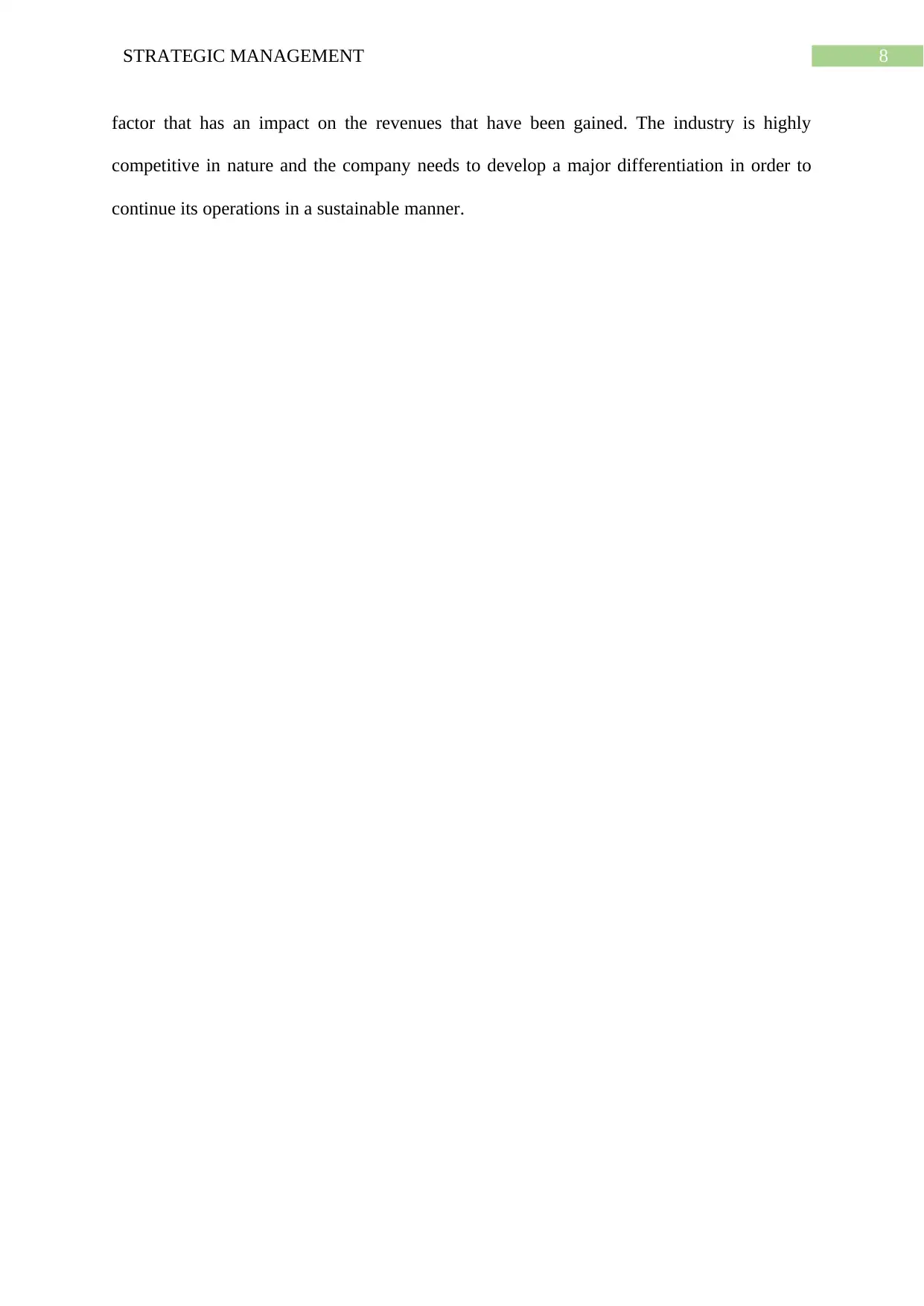
8STRATEGIC MANAGEMENT
factor that has an impact on the revenues that have been gained. The industry is highly
competitive in nature and the company needs to develop a major differentiation in order to
continue its operations in a sustainable manner.
factor that has an impact on the revenues that have been gained. The industry is highly
competitive in nature and the company needs to develop a major differentiation in order to
continue its operations in a sustainable manner.
⊘ This is a preview!⊘
Do you want full access?
Subscribe today to unlock all pages.

Trusted by 1+ million students worldwide

9STRATEGIC MANAGEMENT
References
Agriculture.gov.au 2019. The aquaculture industry in Australia. [online] Agriculture.gov.au.
Available at: http://www.agriculture.gov.au/fisheries/aquaculture/aquaculture-industry-in-
australia [Accessed 8 Jun. 2019].
Bruce, A. and Faunce, T., 2017. Food production and animal welfare legislation in Australia:
Failing both animals and the environment. In International farm animal, wildlife and food
safety law (pp. 359-394). Springer, Cham.
Bruce, A., 2016. Present & Future Jurisprudence of Consumer Protection and Food Law in
Australia. In International Food Law and Policy (pp. 971-1000). Springer, Cham.
Carlucci, D., Devitiis, B.D., Nardone, G. and Santeramo, F.G., 2017. Certification labels
versus convenience formats: What drives the market in aquaculture products?. Marine
Resource Economics, 32(3), pp.295-310.
Dowling, R., 2018. Food, wine and China: a tourism perspective from Western Australia.
In Food, Wine and China (pp. 133-150). Routledge.
Engle, C.R., Quagrainie, K.K. and Dey, M.M., 2016. Seafood and aquaculture marketing
handbook. John Wiley & Sons.
Hine, J., 2015. Trends: Investment in food manufacturing needed. Food Australia, 67(6),
p.22.
Kirkpatrick, J.B., Kriwoken, L.K. and Styger, J., 2019. The reverse precautionary principle:
science, the environment and the salmon aquaculture industry in Macquarie Harbour,
Tasmania, Australia. Pacific Conservation Biology, 25(1), pp.26-33.
References
Agriculture.gov.au 2019. The aquaculture industry in Australia. [online] Agriculture.gov.au.
Available at: http://www.agriculture.gov.au/fisheries/aquaculture/aquaculture-industry-in-
australia [Accessed 8 Jun. 2019].
Bruce, A. and Faunce, T., 2017. Food production and animal welfare legislation in Australia:
Failing both animals and the environment. In International farm animal, wildlife and food
safety law (pp. 359-394). Springer, Cham.
Bruce, A., 2016. Present & Future Jurisprudence of Consumer Protection and Food Law in
Australia. In International Food Law and Policy (pp. 971-1000). Springer, Cham.
Carlucci, D., Devitiis, B.D., Nardone, G. and Santeramo, F.G., 2017. Certification labels
versus convenience formats: What drives the market in aquaculture products?. Marine
Resource Economics, 32(3), pp.295-310.
Dowling, R., 2018. Food, wine and China: a tourism perspective from Western Australia.
In Food, Wine and China (pp. 133-150). Routledge.
Engle, C.R., Quagrainie, K.K. and Dey, M.M., 2016. Seafood and aquaculture marketing
handbook. John Wiley & Sons.
Hine, J., 2015. Trends: Investment in food manufacturing needed. Food Australia, 67(6),
p.22.
Kirkpatrick, J.B., Kriwoken, L.K. and Styger, J., 2019. The reverse precautionary principle:
science, the environment and the salmon aquaculture industry in Macquarie Harbour,
Tasmania, Australia. Pacific Conservation Biology, 25(1), pp.26-33.
Paraphrase This Document
Need a fresh take? Get an instant paraphrase of this document with our AI Paraphraser

10STRATEGIC MANAGEMENT
Lacoste, M., Lawes, R., Ducourtieux, O. and Flower, K., 2017. Methods to Study
Agricultural Systems. In Sustainable Agriculture Reviews (pp. 115-148). Springer, Cham.
Lawley, M. and Birch, D., 2016. Exploring Point of Sale Strategies for Improving Seafood
Retailing: The Case of the Australian Oyster Industry. Journal of food products
marketing, 22(7), pp.792-808.
Rahman, M., Khatun, A., Liu, L. and Barkla, B., 2018. Brassicaceae mustards: Traditional
and agronomic uses in Australia and New Zealand. Molecules, 23(1), p.231.
Tassal.com.au 2019. About Us - Tassal Tasmanian Salmon. [online] Tassal Tasmanian
Salmon. Available at: http://www.tassal.com.au/about/ [Accessed 8 Jun. 2019].
Lacoste, M., Lawes, R., Ducourtieux, O. and Flower, K., 2017. Methods to Study
Agricultural Systems. In Sustainable Agriculture Reviews (pp. 115-148). Springer, Cham.
Lawley, M. and Birch, D., 2016. Exploring Point of Sale Strategies for Improving Seafood
Retailing: The Case of the Australian Oyster Industry. Journal of food products
marketing, 22(7), pp.792-808.
Rahman, M., Khatun, A., Liu, L. and Barkla, B., 2018. Brassicaceae mustards: Traditional
and agronomic uses in Australia and New Zealand. Molecules, 23(1), p.231.
Tassal.com.au 2019. About Us - Tassal Tasmanian Salmon. [online] Tassal Tasmanian
Salmon. Available at: http://www.tassal.com.au/about/ [Accessed 8 Jun. 2019].
1 out of 11
Related Documents
Your All-in-One AI-Powered Toolkit for Academic Success.
+13062052269
info@desklib.com
Available 24*7 on WhatsApp / Email
![[object Object]](/_next/static/media/star-bottom.7253800d.svg)
Unlock your academic potential
Copyright © 2020–2025 A2Z Services. All Rights Reserved. Developed and managed by ZUCOL.




